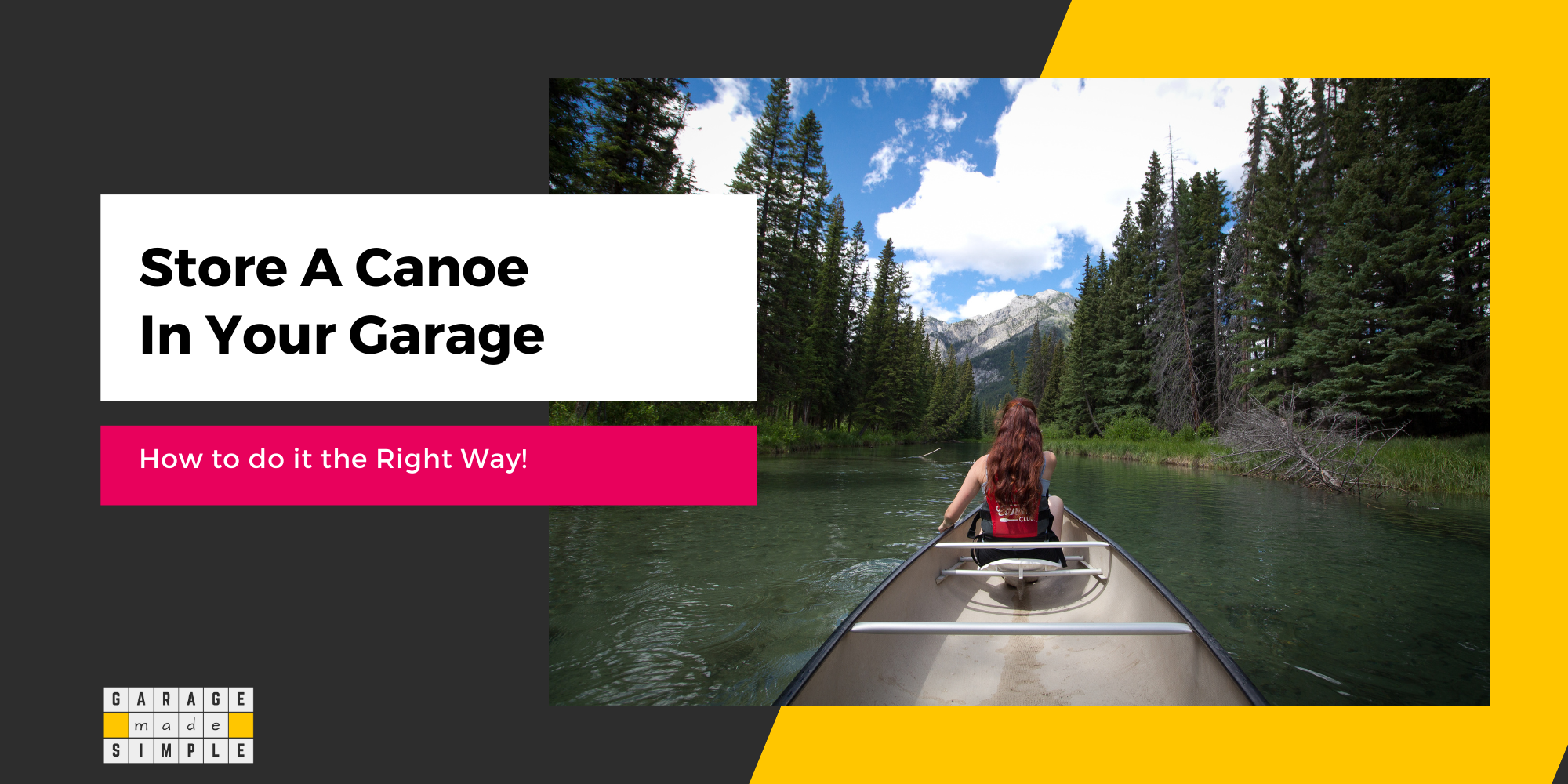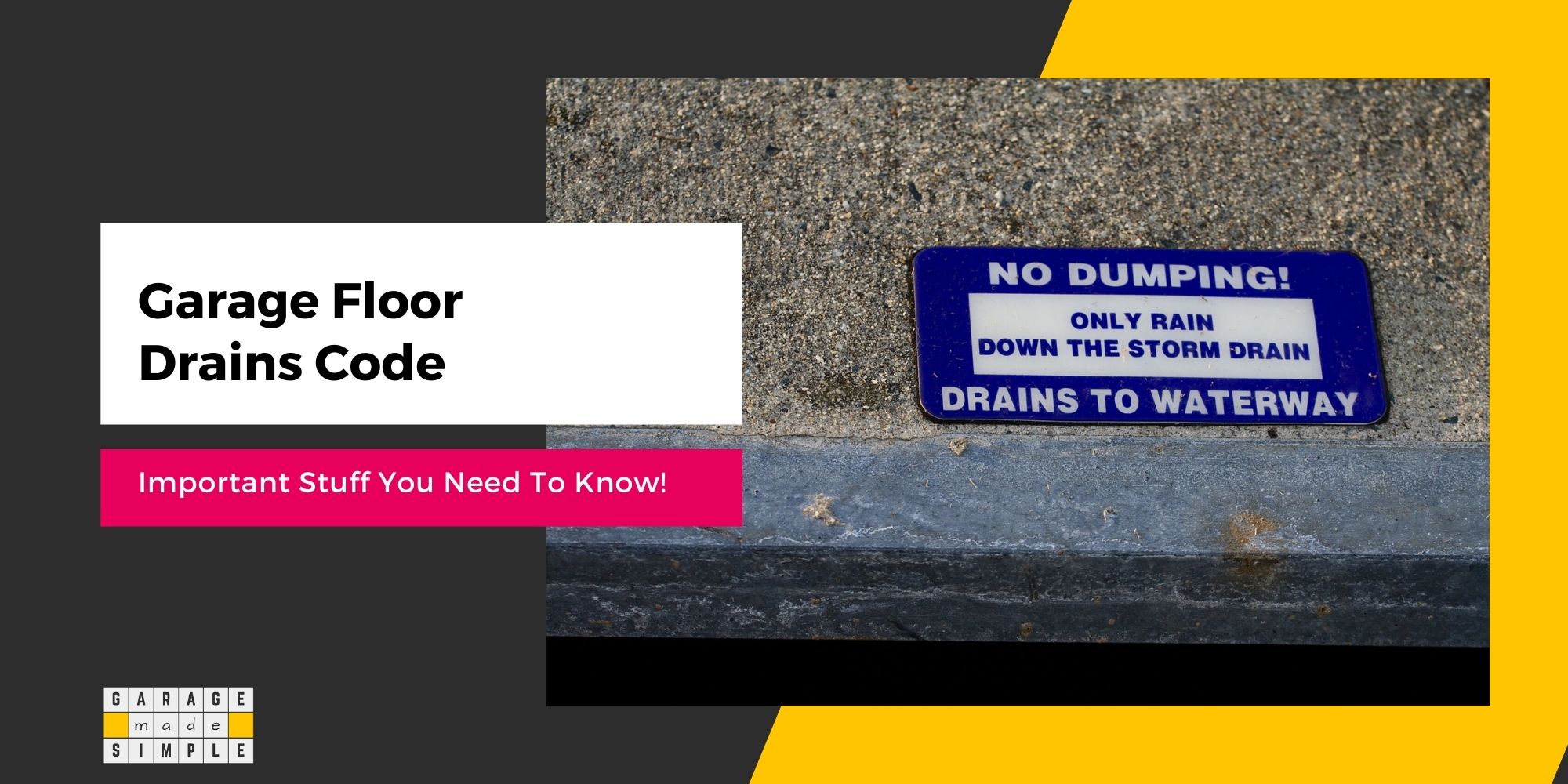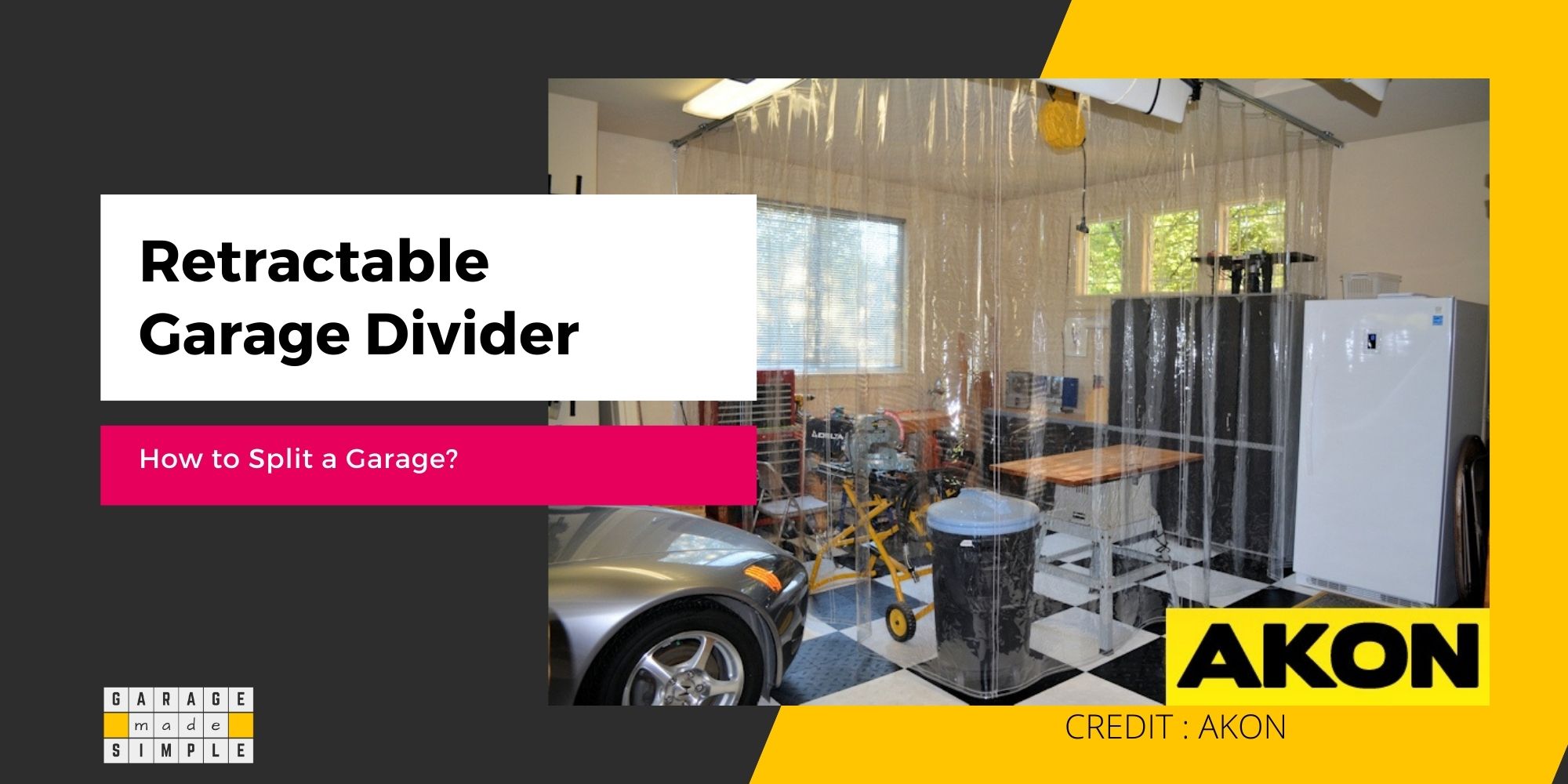Building a Garage On a Steep Slope: The Ultimate Construction Guide
As an Amazon Associate, I earn from qualifying purchases.
Is your house on a sloping lot and you plan to add a detached garage? But is building a garage on a steep slope possible? If yes, how do you do it?
Building a garage on a steep slope is certainly possible. But it needs lots of ingenuity, know-how, skill, and extra cash.
Steep terrain poses unique obstacles, such as drainage management, soil stability, and ensuring a safe and functional structure.
However, with the right planning, design, and construction techniques, you can build a garage on a steep slope that enhances your property’s value while complementing the natural landscape.
Disclaimer: The purpose of this blog post is purely to inform and give general advice. No two lots in the world are the same. It is best ultimately to use the services of a qualified architect. This post will, however, help you ask the right questions and understand the solutions provided.
Let me explain some of the best ways of building a garage on a steep slope (and gentler ones too!).
By the end of this article, you’ll understand how to evaluate your site, select the best foundation type, and implement essential construction techniques for sloped garages.
7 challenges must be addressed when building a garage on a slope. The key takeaways are listed here, but you can find a detailed explanation further in the post.
Key Takeaways for Building a Garage on a Steep Slope
| No. | Challenge | Key Feature |
|---|---|---|
| 1 | Higher Costs | Additional expenses for soil testing, professionals, excavation, and foundations. |
| 2 | Soil Stability Reports | Essential for safe design based on terrain characteristics. |
| 3 | Innovative Design | Slope orientation affects layout and entry options. |
| 4 | Extensive Excavation | Vertical designs lower costs and improve water management. |
| 5 | Erosion Control | Retaining walls and mulching prevent erosion and water damage. |
| 6 | Drainage Requirements | Proper drainage prevents erosion and guides water away. |
| 7 | Waterproofing Essential | Protects below-grade foundations from water infiltration. |
3 Storey Home on Steep Slope with Grass Roofed Garage
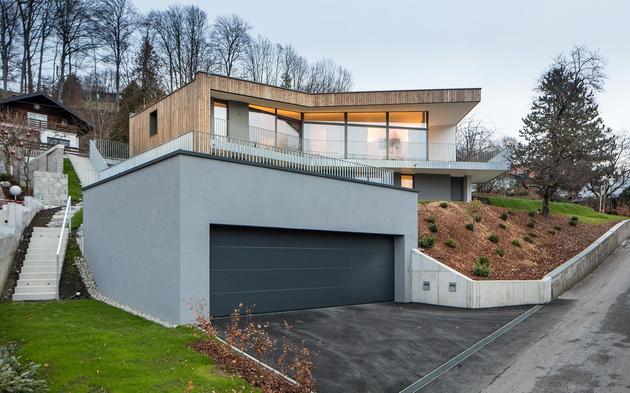
The large two-car garage is completely hidden from the home by its grassy roof and the landscaped slope to its side. The garage accesses the house through a stairwell in a tunnel under the ground.
ABOUT TRENDIR
trendir.com is an up-and-coming community specializing in high-quality and on-trend cool projects and tutorials in home design, fashion, and crafts.
Gentle Slope vs Steep Slope
A sloping lot can mean different things to different people. How steep is steep does not have any definitive answer. Each person may have his own idea of differentiating between a gentle slope and a steep slope.
Steep Slope
Nashua Regional Planning Commission in its FACT SHEET: 12 defines
“Steep slopes are legally defined as hillsides having a 15 foot, or greater, vertical rise over 100 feet of horizontal run, or 15% slope. They are often undesirable areas for development due to the difficulty of building on steep grades.”
Let us put this definition in the perspective of a 20’X20’ garage. If one end of the garage is going to be 3’ or higher, then we are over the 15% limit and technically in the steep slope zone.
Gentle Slope
Going by technicalities, a height difference of less than 3’ would make it a gentle slope. Intuitively, we know that can’t be the case. I would like to think that a height difference of 6” or less ( A slope of 2.5% or less) should be considered as a gentle slope.
Anything more, and we are better off using the techniques of building a garage on a steep slope. At least some of them!
I will just go ahead and assume that we are on the same page when it comes to our understanding of a gentle slope and a steep slope.
Design Considerations for a Steep Slope Garage
Designing and building a garage on a steep slope involves careful planning to maximize functionality, safety, and aesthetics. The garage placement, driveway accessibility, and structural style must be tailored to your site’s unique terrain.
Garage Placement and Orientation
Garage placement will depend on site accessibility, driveway slope, and aesthetics vis-a-vis the surrounding landscape. Consider these points:
- Ease of Access: Position the garage to allow for the shortest and safest driveway route. This reduces excavation and grading costs.
- Views and Privacy: Orient the garage to complement existing structures and maintain desirable views from your home, if applicable.
- Minimizing Disturbance: Avoid areas with unstable soil or vegetation critical for erosion control. Placing the garage closer to the road can reduce environmental disruption.
Choosing the Right Garage Style
Your garage style should balance functionality with the slope’s demands. Popular options include:
- Attached Garages:
- Benefits: Offers direct access to the home and leverages the house’s existing foundation for stability.
- Ideal for: Moderately sloped sites where integration is straightforward.
- Detached Garages:
- Benefits: Provides flexibility in placement and reduces noise transfer to the home.
- Ideal for: Steeper slopes where a separate structure simplifies construction.
- Split-Level Designs:
- Benefits: Tailored for steep terrains, split-level garages can feature separate storage or workspace areas on different levels.
- Ideal for: Slopes above 20%, allowing the garage to “step” with the land.
Visualize your options to find the best match for your needs and the topography. For example, a split-level garage on a steep slope can optimize both space and stability.
Driveway Design for Accessibility
A well-designed driveway is essential for safe and convenient garage access. Sloped driveways can be challenging, especially in regions prone to ice, snow, or heavy rain.
Key considerations include:
- Gentle Slope: Aim for a gradient no steeper than 10–12% for vehicles to navigate comfortably.
- Curved or Switchback Driveways: reduce the grade while adding aesthetic appeal. This design is a good option for extremely steep slopes.
- Surface Material: Choose non-slip materials like concrete or asphalt, and consider adding textured finishes for better traction.
Include drainage solutions such as grated channels or culverts to prevent water pooling on the driveway and damaging the garage foundation.
Foundation Options for Steep Slopes
The foundation is the structure that transfers the load of the entire building to the ground. It also keeps out the groundwater and acts as a barrier to water & soil vapor.
Choosing the right foundation is one of the most critical decisions when constructing a garage on a steep slope.
The foundation must provide stability, accommodate the terrain, and support the structure’s weight while resisting soil movement.

Here, I’ll explore the most effective foundation types and how to select the best option for your project. One of the three below should work.
- Stepped Foundation
- Description: A stepped foundation follows the slope’s contour, consisting of multiple levels that create a stable base.
- Advantages: This design reduces the need for extensive excavation while minimizing soil disturbance. It is ideal for moderate slopes.
- Construction Tips:
- Ensure each step is reinforced with rebar to handle lateral forces.
- Incorporate proper drainage at each level to avoid water accumulation.
- Pier Foundation
- Description: This foundation uses vertical piers to elevate the garage above the slope. Piers are driven deep into the ground, anchoring the structure securely.
- Advantages: Suited for steep slopes, it minimizes excavation, allows for airflow beneath the garage, and prevents moisture buildup.
- Construction Tips:
- Use pressure-treated wood or reinforced concrete for durability.
- Ensure piers are spaced appropriately to distribute the load evenly.
- Slab-on-Grade with Retaining Wall
- Description: A concrete slab is poured over a level base created by a retaining wall. The retaining wall holds back soil to create a flat surface.
- Advantages: Works well for moderate to steep slopes and provides a solid, cost-effective base.
- Construction Tips:
- Reinforce the retaining wall with rebar and drainage pipes to prevent pressure buildup.
- Use waterproof membranes under the slab for additional protection.
Please read my earlier blog post to learn more about 7 Important Things To Know About A Concrete Garage Floor.
Choosing the Best Foundation for Your Site
The best foundation depends on slope severity, soil type, and budget. Use this guide to decide:
- Mild to Moderate Slopes (0–15%): A stepped foundation is often sufficient, offering stability while reducing costs.
- Steep Slopes (15% or more): Consider a pier foundation for its flexibility and minimal excavation.
- Challenging Soil Conditions: If the soil has low stability (e.g., clay-heavy), a retaining wall with a slab foundation provides both structural support and erosion control.
Pro Tip: Combine a professional soil analysis with an engineer’s recommendation to ensure the chosen foundation meets local building codes and safety requirements.
Benefits of Building a Garage on a Steep Slope
Spectacular Views
Building a garage on a steep slope does come with a lot of challenges. But, on the other hand, building a garage on a steep slope can open up spectacular views to die for. You may be overlooking a placid lake, a gurgling stream, or green meadows.
Two Level Advantage
Building a garage on a steep slope will let you have two levels. One level would of course be the garage. Depending on the orientation you could have a beautiful terrace on top of the garage or a cozy relaxation lounge below the garage.
Challenges of Building a Garage on a Steep Slope
It is an understatement to say that building a garage on a steep slope is challenging. Here are seven that will give you sleepless nights, for sure!

1. Involves Higher Cost
Building a garage on a steep slope is going to cost you a lot more. To begin with, this can not be a DIY project. You will spend extra money on
- Soil Testing and Terrain Stability Reports
- Engaging an Experienced Architect & Builder
- Excavation of the Hillside
- Special Foundations & Retaining Walls
- Drainage & Waterproofing
2. Soil Testing & Terrain Stability Reports
You will need to get the soil tested not just where you are going to build the garage but also the area around it. Different types of soils will present different challenges.
If the soil has too much clay then drainage will be a problem to worry about the most. High clay-content soils tend to hold water and drain poorly.
Soil with a fair amount of granularity will make the job easier. It is easier to excavate and easier to drain too. You just do not want it to be so sandy that it has little stability and will erode easily.
Rocky terrain is great for structural stability but excavation costs will shoot through the roof. You will also have to provide drains such that the rainwater or snowmelt can be diverted safely around the building.
3. Innovative Design Requirement
The Garlinghouse Company has more than 1,000 hillside house plans for you to choose from. Whether you’d like a chalet-style home for your mountain retreat or a classic Cape Cod for your in-town home, there’s a hillside plan for you.
The design, location, and orientation of the garage will be greatly influenced by the lay of the land. Will the driveway and therefore the garage door be on the higher end of the slope or the lower end?
Here are two hillside house plans with a garage that will give you an idea. Check out their website for more options. Depending on the lot layout the garage entry could be from the front of the house or the side of the house.
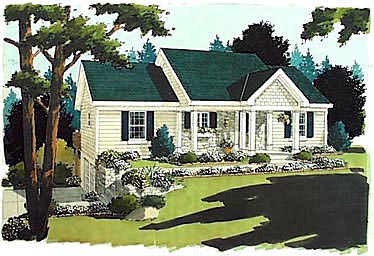
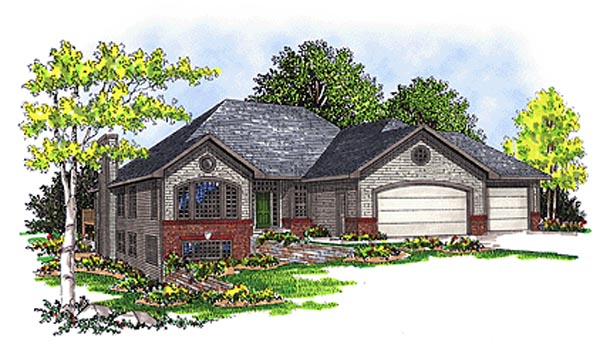
Disclaimer: I am not affiliated to The Garlinghouse Company or https://www.familyhomeplans.com/, financially or otherwise. The information is provided purely as helpful information to my readers.
4. Typically Needs Extensive Excavation
More likely than not, you will need to excavate. Excavation on a steep slope is expensive and time-consuming. Sometimes even access available to the heavy earth-moving machinery may not be there.
A solution to this problem is to build vertically as much as possible. Instead of a two-floor house, with each floor spread over 1500 square feet, try to come up with a design for a three-floor house, with each floor spread over 1000 square feet.
This not only reduces the area of the land that needs to be excavated it also reduces the “impermeable surface” substantially.
This will be very useful when it comes to water management.
5. Addressing the Issue of Erosion
Building a house or a garage for that matter on a steep slope has to necessarily address the issue of erosion, particularly of the soil on the higher end of the slope.
Retaining Wall
The excavation must allow space to build a retaining wall. The role of the retaining wall is to hold or retain the soil behind it. A retaining wall takes the load of the high ground so that it is not transmitted to the house or the garage.
The retaining wall acts as a drainage regulator and channels water and mud around the house rather than onto the house, which could cause considerable damage.
A retaining wall can be made of concrete blocks, poured concrete, treated timbers, rocks, or boulders.
Mulch
Mulch is another technique used to prevent soil erosion. It is best to use it along with a retaining wall and not as an alternative.
Mulch consists of a thick layer of materials such as bark chips, pine needles, wood chips, stones, or river rocks placed on the soil.
Mulch breaks the force of the flow of rainwater or snow melt as it passes through it into the soil below. This helps to prevent erosion.
6. Drainage Needs Special Attention
When building a house or a garage for that matter on a steep slope, drainage takes on a lot more importance than on flat land. Proper drainage is critical when building a garage on a steep slope to
- Help reduce soil erosion
- Waterproof the structure
- Reduce water pressure on the structure
- Guide the water away from the structure
French Drain
The technique is basically to use a French Drain System, all around the perimeter of the garage, including the house, in the case of an attached garage.
The section of the French Drain that is perpendicular to the slope and uphill, should be a perforated PVC pipe that is embedded into the soil. The pipe should be placed in a U-shaped waterproof concrete trench.
The top of the pipe and the U-shaped trench should be covered with small washed rounded gravel the size of golf balls or walnuts.
The stones or gravel should of course be bigger than the perforations so that they do not get washed away in the drain. The gravel should extend up to within 4 inches of the top of the final grade, where you have grass growing.
Water passing through the soil would discover this gravel and immediately drop down through it into the French Drain, through the perforations in the PVC pipe.
The PVC pipe would guide the water around the structure, downhill to a stormwater drain or daylight as the case may be.
Use more than one set of such perforated PVC pipes, spaced a few feet apart on the top end of the hill if the precipitation in your area is particularly heavy.
7. You Can Not Ignore Waterproofing
As part of your garage foundation walls will be below the grade, waterproofing at the construction stage is essential.
Homeowners often assume that “damp proof” and “waterproof” are the same thing. They most certainly are not.
US Waterproofing explains the difference as under:
“Damp proofing resists the passage of water in the absence of hydrostatic pressure; waterproofing stops the passage of water under pressure”.
Source: uswaterproofing
Damp proofing may be OK for foundations built on level ground but it is not enough for foundations built on a steep slope. Only waterproofing and not dampproofing will work.
Construction Steps: A Detailed Walkthrough
Building a garage on a steep slope requires precision and adherence to best practices at every stage. This step-by-step guide ensures that your garage is not only functional but also stable, safe, and compliant with building codes.

1. Excavation and Grading
- Clear the Site:
- Remove vegetation, debris, and topsoil while minimizing disturbance to surrounding areas to prevent erosion.
- Mark the layout of the garage foundation using stakes and string.
- Excavate for the Foundation:
- Use heavy equipment to dig according to the foundation type (e.g., terraced steps for a stepped foundation or postholes for piers).
- Maintain proper slope grading to direct water away from the construction area.
- Prepare for Drainage:
- Install temporary drainage solutions, such as trenches or diversion barriers, to manage water runoff during construction.
2. Building Retaining Walls (If Applicable)
- Excavate for the Retaining Wall:
- Dig a trench for the retaining wall’s base at the required depth for stability.
- Compact the soil at the base to prevent settling.
- Construct the Wall:
- Pour a concrete footing for stability.
- Build the retaining wall using concrete blocks, stone, or poured concrete, incorporating reinforcements like rebar.
- Install drainage pipes or weep holes to relieve water pressure behind the wall.
3. Constructing the Foundation
- Set Footings:
- Dig trenches for footings and pour reinforced concrete to provide a stable base for the garage walls or piers.
- Ensure footings are level and cured properly to prevent settling.
- Form and Pour Foundation Walls:
- For a stepped foundation: Create forms for each level and pour concrete in stages, allowing each step to cure before proceeding.
- For slab-on-grade: Install formwork for the slab, ensuring the base is level and compact.
- Install Piers (If Applicable):
- Drill or dig holes for piers to the specified depth and insert reinforced concrete or treated wood posts.
- Secure piers with brackets to support the garage structure.
4. Framing, Sheathing, and Roofing
- Frame the Garage:
- Start with the floor joists and secure them to the foundation. For piers, attach the framing to the brackets on top of the posts.
- Assemble wall frames and secure them in place, ensuring they are level and plumb.
- Install Sheathing:
- Attach exterior-grade plywood or OSB (oriented strand board) to the framing for structural stability.
- Build the Roof:
- Erect roof trusses or rafters and secure them to the walls.
- Apply roof sheathing and cover with weatherproof materials like shingles or metal panels.
5. Installing Garage Doors and Windows
- Install Garage Doors:
- Use a track system and adjust for alignment to ensure smooth operation.
- Seal gaps at the bottom of the door to prevent water infiltration on sloped terrain.
- Add Windows:
- Install energy-efficient windows with proper sealing to prevent drafts and water leakage. Position them to allow natural light while maintaining insulation.
6. Finalizing Drainage and Erosion Control
- Install Permanent Drainage Solutions:
- Add French drains, gutter systems, and channel drains to divert water away from the garage and foundation.
- Use gravel or crushed stone around the foundation for additional drainage.
- Erosion Control Measures:
- Apply mulch or gravel to exposed soil areas.
- Plant vegetation with strong root systems to stabilize the slope.
7. Post-Construction Checks and Finishing Touches
- Inspection:
- Schedule a final building inspection to confirm compliance with local building codes.
- Paint and Seal:
- Apply weather-resistant paint and sealant to the garage’s exterior for protection against the elements.
Essential Considerations for Steep Slopes
Addressing environmental and structural challenges when building a garage on a steep slope is crucial.
Proper drainage systems, waterproofing techniques, and erosion control not only protect the structure but also prevent damage to the surrounding landscape.
Drainage and Waterproofing
Water management is a top priority for steep slope construction, as improper drainage can lead to foundation damage, soil erosion, and flooding. Implement these strategies to safeguard your garage:
- Grading and Sloping
- Grade the site to slope water away from the garage foundation. A minimum slope of 5% (approximately 6 inches per 10 feet) is recommended.
- Add swales or berms to direct water flow and reduce runoff velocity.
- French Drains
- Install French drains along the base of retaining walls or the perimeter of the foundation. These systems use perforated pipes surrounded by gravel to channel water away.
- Ensure the drain outlets lead to a safe discharge area, such as a stormwater drain or natural runoff channel.
- Waterproofing Materials
- Apply waterproof membranes or coatings to foundation walls to prevent water infiltration.
- Use exterior insulation boards to protect the waterproofing layer and improve energy efficiency.
Erosion Control
A steep slope is particularly vulnerable to soil erosion. Stabilize the surrounding terrain using the following methods:
- Retaining Walls
- Reinforce retaining walls with proper drainage systems to hold back soil and reduce erosion.
- Use tiered walls for particularly steep slopes to create flat, stable zones.
- Mulching
- Spread a layer of mulch or straw over exposed soil to reduce runoff and protect the ground from heavy rainfall.
- Mulch also improves soil moisture retention, promoting vegetation growth.
- Planting Vegetation
- Choose native, deep-rooted plants like groundcovers or shrubs to anchor the soil. Plants such as creeping juniper or switchgrass are ideal for stabilizing steep slopes.
- Incorporate landscaping fabric under planted areas to further reduce erosion while promoting drainage.
Combining Strategies for Maximum Effect
Often, the best results come from combining drainage and erosion control measures. For example:
- Pair French drains with vegetation to manage both runoff and soil stability.
- Use retaining walls and grading techniques to create a multi-layered approach to water and soil management.
Permits, Inspections, and Safety
As in any construction project, compliance with local regulations and maintaining safety can not be compromised when building a garage on a steep slope.
Researching Local Building Codes
Before starting construction, thoroughly research your area’s building codes. Many municipalities have specific regulations for structures on steep slopes to ensure safety and environmental protection.
- Permit Requirements:
- Obtain permits for excavation, grading, foundation work, and overall garage construction.
- Some regions may require additional permits for retaining walls or drainage systems.
- Slope-Specific Rules:
- Check for restrictions on slope grades or limits on site disturbance.
- Be aware of environmental laws protecting waterways or vegetation near your property.
Pro Tip: Consult your local building department for detailed requirements. An experienced local professional can handle the permitting process for you.
Scheduling Inspections
Throughout the construction process, inspections ensure the project meets safety and structural standards. Typical inspection checkpoints include:
- Excavation and Grading: Verifying proper slope stabilization and drainage setup.
- Foundation Installation: Ensuring the foundation is level, reinforced, and properly anchored to the slope.
- Retaining Walls and Drainage: Ensure drainage systems are inspected to confirm functionality and compliance with building codes.
Pro Tip: Coordinate with inspectors early to avoid delays and confirm that inspection schedules align with your construction timeline.
Safety Precautions During Construction
Working on steep terrain presents unique safety challenges. Adhering to proper safety protocols minimizes the risk of accidents for both homeowners and contractors.
- Fall Protection:
- Install guardrails, temporary barriers, or harness systems in areas with steep drop-offs.
- Use scaffolding or ladders with non-slip feet to stabilize workers.
- Proper Tool Handling:
- Use machinery like excavators or graders designed for sloped terrain to avoid tipping hazards.
- Wear safety gear, including hard hats, gloves, and steel-toed boots.
- Awareness of Hazards:
- Monitor for weather-related risks, such as heavy rain that could cause soil movement or unsafe working conditions.
- Mark excavation areas and utility lines clearly to prevent accidental damage or injuries.
Frequently Asked Questions (FAQs)
Can I build a garage on any slope?
Pretty much, but the feasibility depends on the slope’s severity and soil conditions.
Slopes greater than 15% require specialized foundations, retaining walls, and advanced drainage systems.
What is the best foundation type for a steep slope?
The choice depends on the site. Pier foundations work well for very steep slopes, while stepped foundations or slab-on-grade along with retaining walls are ideal for moderate slopes. Soil stability and budget also play a role in the decision.
How do I manage water drainage around a garage on a slope?
Install systems like French drains, swales, or gutter systems to redirect water away from the foundation.
Proper site grading and retaining walls with drainage pipes are essential for managing runoff effectively.
What safety measures should I take during construction on a slope?
Ensure proper fall protection, use tools designed for steep terrain, and monitor weather conditions closely.
Do I need a retaining wall for my sloped garage?
Most steep slope projects benefit from retaining walls to stabilize the soil and create level areas for the foundation or driveway.
Bottom Line
Constructing a garage on a steep slope is a complex yet achievable project with the right planning and expertise.
From site preparation and drainage solutions to choosing the ideal foundation type, every decision plays a critical role in ensuring a safe, durable, and functional structure.
While steep terrain presents unique challenges, it also provides opportunities for innovative designs, such as split-level garages or detached layouts tailored to the landscape.
Thank you very much for reading the post. I do hope you found it informative and useful.

